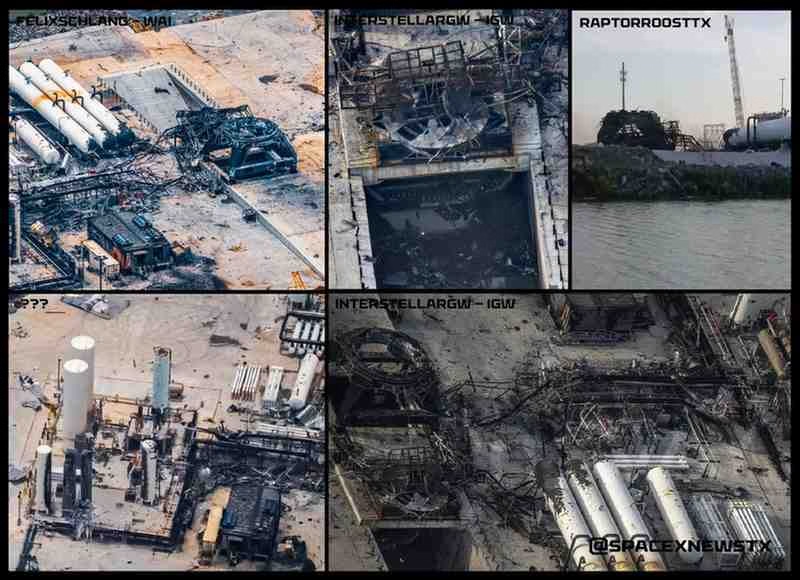Starship 36 explosion sends debris over 200 meters, highlighting the high risks of rocket testing. Learn how dangerous it was and what caused it.

Starship 36 Explosion Shakes Starbase, Debris Thrown 200 Meters from Blast Site
Starship 36 explosion A powerful explosion during the test flight of Starship 36 sent shockwaves through Elon Musk’s Starbase facility in Boca Chica, Texas. The violent failure occurred during a critical phase of the launch sequence and led to a destructive blast that physically shook buildings and equipment across the sprawling private spaceport.
Engineers and staff on site reported feeling the ground tremble beneath them as the fully fueled Starship vehicle erupted in a massive fireball. The explosion, which followed a suspected failure during stage separation or upper-stage ignition, was among the most forceful seen at Starbase to date. The sound was heard miles away, and the blast’s impact was felt across much of the surrounding area.
One of the most dramatic outcomes of the explosion was the scattering of large debris. A portion of Starship’s nosecone was reportedly thrown more than 200 meters away from the main blast site. Such a distance highlights the extreme power of the detonation and raises important questions about the size of the exclusion zone around the launch pad.
Though the site is designed to handle test anomalies, the strength of the explosion will likely prompt a fresh safety review by SpaceX and regulatory agencies. The Federal Aviation Administration is expected to conduct an investigation into the incident to determine the cause and ensure safety compliance before further launches proceed.
No injuries were reported when Starship 36 explosion, as the area had been cleared before the test flight in accordance with standard procedures. However, the sheer force of the blast and the scattering of debris underscored the risks involved in launching a fully fueled Starship-Super Heavy system. The rocket carried thousands of tons of liquid methane and liquid oxygen, which contribute to the intensity of any failure.
Starbase is central to Elon Musk’s long-term vision for interplanetary space travel. It serves as the main development and test center for SpaceX’s Starship program, a key component of future missions to the Moon, Mars, and beyond. The Starship system is designed to be fully reusable and capable of carrying both cargo and crew, making it one of the most ambitious spaceflight programs in history.
While this incident represents a significant setback in the short term, it also provides SpaceX engineers with valuable data. Explosive failures, while dramatic, are part of the iterative development approach SpaceX has long adopted. Each test brings the company closer to refining the technology and achieving full mission success.
The Starship 36 explosion marks a high-profile moment in SpaceX’s ongoing efforts, not just for the destruction caused, but for the scale of its impact across the Starbase site. As development continues, the company will need to balance the speed of innovation with reinforced safeguards to protect both personnel and infrastructure.
News Source:-
https://x.com/SpaceXNewsTX/status/1936441111733821942?t=40nzCFti4EBTThOLaJdQsQ&s=19
https://x.com/interstellargw/status/1937188820992106674?t=R-TmrWmbi690ADumyckJVg&s=19
How Dangerous Was the Starship 36 Explosion?
1. Power of the Blast
The explosion of Starship 36 involved a fully stacked Super Heavy booster and Starship upper stage. Together, they contain over 4,800 tons of liquid methane and liquid oxygen—an extremely powerful combination. The blast likely released energy equivalent to tons of TNT, enough to cause major damage within a wide radius.
2. Flying Debris
One of the most alarming outcomes of the explosion was that a fragment of the nosecone was reportedly thrown over 200 meters (656 feet) away. A piece of metal traveling at high velocity can be lethal. If people had been in the wrong place—such as outside a safety perimeter—serious injury or death could have occurred.
3. Shockwave and Thermal Effects
Such an explosion generates a shockwave strong enough to damage equipment, crack windows, or cause injury to anyone too close. It also produces extreme heat and fire hazards at the launch site.
4. Environmental and Structural Risk
The explosion could have damaged launch pad infrastructure, ignited brush fires, or introduced toxic fumes into the air. The surrounding environment, including wildlife and nearby buildings, could be impacted.
5. Range Safety and Risk Management
Thankfully, the explosion happened in a controlled test environment at SpaceX’s Starbase in Boca Chica, Texas. Strict range safety protocols and exclusion zones likely prevented harm to personnel. These protocols are designed to withstand such scenarios, though the debris distance may prompt reviews of the safety zone sizes.
Why Did It Happen?
While the exact cause of the explosion is still under investigation, early observations suggest a failure during stage separation or a malfunction in the propulsion system. Starship 36 was part of SpaceX’s test series to refine the architecture for future orbital missions and eventual crewed flights.
Starship 36 Explosion: At a Glance
- The Starship 36 explosion was extremely powerful and potentially hazardous.
- A nosecone fragment flying over 200 meters shows how violent the blast was.
- No injuries occurred, thanks to strict safety protocols.
- The incident reinforces the need for robust risk assessments and flight termination systems in large rocket testing.
Venturi Space Reveals- Mona Lena Lunar Rover: Europe’s Bold Step Toward the Moon
